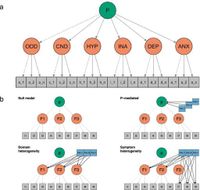Childhood is a critical period for emotional and behavioral development, with difficulties often foreshadowing future neuropsychiatric conditions. A recent study highlights the importance of parental genetic factors in shaping children’s emotional and behavioral symptoms, offering insights that may advance preventive strategies.
Researchers from the Norwegian Institute of Public Health conducted an extensive examination of data from the Norwegian Mother, Father and Child Cohort Study (MoBa), specifically looking at how parental polygenic risk influences emotional and behavioral difficulties in 14,959 families. Their findings indicate a complex interplay of direct genetic transmission and environmental factors that contribute to a child's psychological state.
"This study reveals the complex interplay between direct genetic transmission and environmental factors in contributing to childhood emotional and behavioral difficulties," wrote the authors of the article. By analyzing data obtained when the children were eight years old, the research identified specific symptoms such as anxiety and restlessness, organized into more general and specific categories.
The study builds on previous research knowledge that emotional and behavioral challenges often co-occur in children and may signal potential future disorders. Notably, it emphasizes the role of parental mental health as a foundational risk factor. Earlier studies established that parents with neuropsychiatric conditions might pass these vulnerabilities onto their offspring through both genetic and environmental pathways.
The researchers distinguished between two primary routes of transmission: direct genetic effects, where risks are inherited biologically, and indirect genetic effects that are mediated through family dynamics and upbringing. This section of the research utilized polygenic scores (PGS) as predictors of genetic predisposition. For instance, traits linked with conditions such as attention deficit hyperactivity disorder (ADHD) and anxiety were significant markers.
Leveraging a large genotyped cohort is vital in discerning these pathways. The thorough approach allowed the authors to avoid inflated estimates often found in studies of single children, reinforcing the reliability of their findings. The results showed that while genetic factors do influence emotional and behavioral difficulties, a substantial environmental component originating from parents also plays a critical role in shaping child outcomes.
However, the interplay of genetic and environmental factors is nuanced. Indirect genetic effects can produce environmental influences through parental behaviors, such as parenting styles influenced by parental depression or anxiety. The study conjoined maternal and paternal scores to quantify these effects comprehensively, revealing the extent of their impact on children.
In a detailed analysis, the authors utilized a second-order hierarchical model to organize the observed symptoms into specific domains. Findings indicated that while general predispositions contributed to a wide range of emotional and behavioral challenges, specific traits also significantly influenced particular domains. For instance, the ADHD polygenic score consistently emerged as a strong predictor of various difficulties across the board, while fears and anxieties correlated more specifically with parental neuroticism.
Importantly, the study underscores the need to recognize both shared and distinctive risk factors by asserting that not all parental influences are uniform. The researchers stated, "Identifying shared and specific risk factors is crucial for developing effective prevention strategies," thus emphasizing a tailored approach in addressing childhood mental health. Understanding these influences can sharpen intervention strategies aimed at mitigating risks in vulnerable children.
In conclusion, the research compiled from the MoBa cohort reinforces the dual influence of genetics and the environment on childhood emotional and behavioral difficulties. By recognizing how parental characteristics, both genetic and environmental, shape these challenges, stakeholders can craft more effective, targeted interventions to support children at risk. The findings highlight the significance of preventive measures that attend to the entire familial context surrounding childhood development, aiming to break the intergenerational cycles of emotional difficulties.




